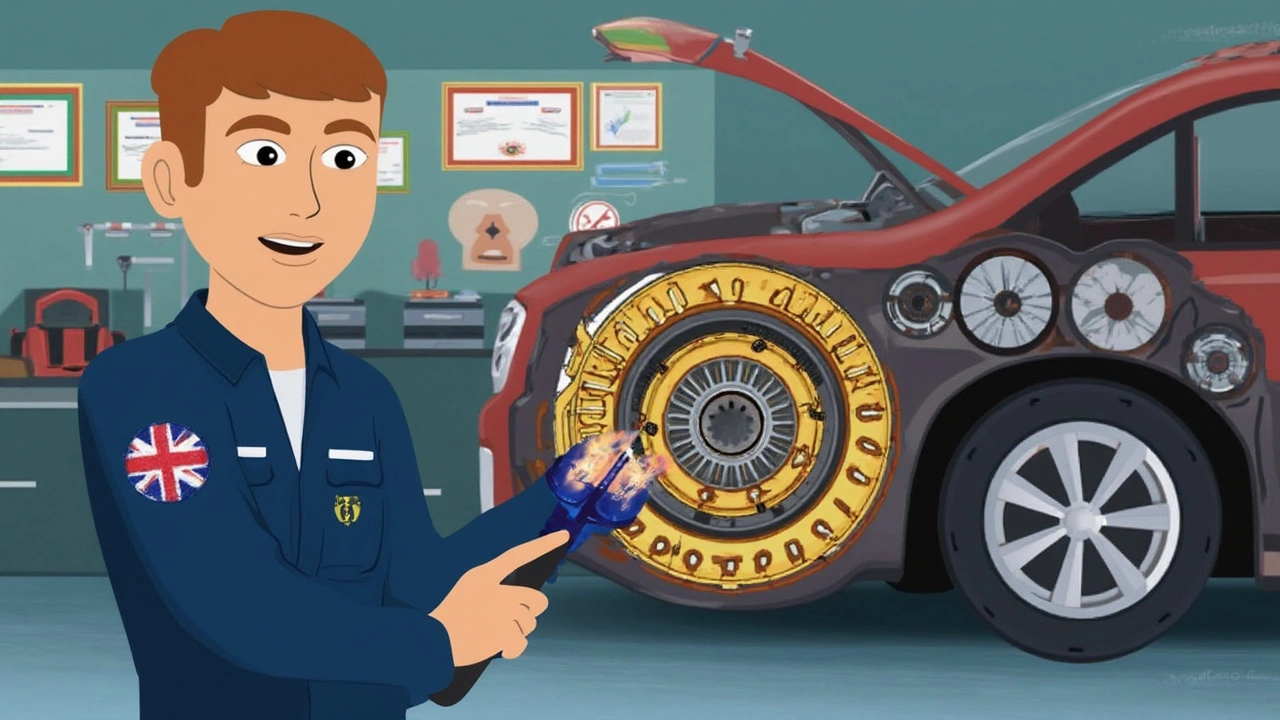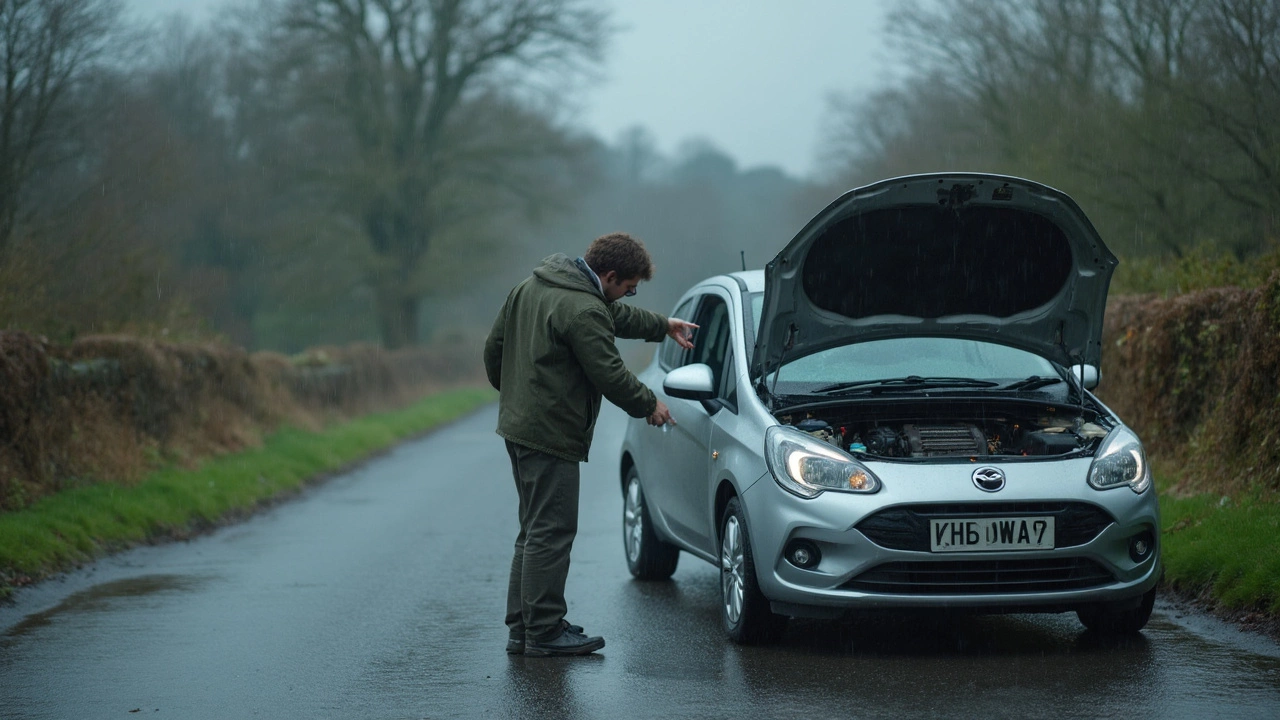If your clutch just gave up on you, your first thought might be—can I still drive? Here’s the reality: when your clutch breaks, the link between your engine and wheels is basically toast. That means shifting gears turns into an uphill battle, if not impossible.
A lot of folks try to push through by forcing the car into gear, but that usually just leads to more grinding, noise, and expensive repair bills. Even if you manage to move the car a few feet, you’re risking bigger damage to your gearbox and maybe even your engine.
If you’re reading this while stuck on the side of the road, your best bet isn’t to hope for a miracle but to figure out your next safe step. Stick around for tips on spotting a dying clutch, why driving with it is risky business, and what you should do if you really need to move the car in an emergency.
- How the Clutch Actually Works
- Signs Your Clutch is Broken
- What Happens If You Try to Drive Anyway?
- Emergency Moves: Can You Limp Home?
- Risks of Driving with a Faulty Clutch
- When to Call for Repairs (and What Happens Next)
How the Clutch Actually Works
Let’s break down what’s really going on when you step on the clutch pedal. Your clutch is basically the go-between for your engine and your wheels. Without it, you’d be stuck in one gear—forever.
Here’s the nuts and bolts of it: the clutch lets you disconnect the engine from the wheels so you can change gears without crunching metal. That little pedal you press controls a disc that presses up against the spinning engine flywheel. When you push the pedal in, it pulls the disc away—sort of like taking your foot off the gas in a go-kart so you can stop safely.
Modern clutches handle a lot of abuse. The friction material on the clutch disc is built to take the heat from all those shifts and starts. Problems start popping up after thousands of gear changes, especially in heavy traffic or stop-and-go driving.
"The clutch is a critical safety and drivability component—ignoring issues can lead to catastrophic transmission damage."
—Haynes Manual, Clutch System Basics
| Component | What It Does |
|---|---|
| Clutch Pedal | Lets you control the clutch system with your foot |
| Clutch Disc | Connects or disconnects power from engine to wheels |
| Pressure Plate | Keeps the disc pressed against the flywheel |
| Flywheel | Spins with the engine; clutch grabs on to this |
| Release Bearing | Helps the disc pull away when you press the pedal |
Every time you use the clutch, you’re putting all these parts to work. The thing is, the broken clutch problem usually starts with the disc or the hydraulics wearing out, making gear changes stiff, noisy, or impossible—especially if you really need that car to move.
If you’ve ever driven in city traffic for a month straight, you’ve put your clutch through hundreds of cycles. Average clutches in small cars last about 60,000 to 100,000 miles, but towing or hard driving can cut that down by half.
Signs Your Clutch is Broken
If your car isn’t acting right, there are some dead giveaways the clutch might be finished. Not every problem with shifting means a full breakdown, but if you ignore these signs, you’re asking for trouble.
- You find it tough or impossible to shift gears, sometimes needing two hands to force the stick.
- The engine revs up, but your speed barely changes—or doesn't change at all. That’s called clutch slip and it’s a classic sign.
- You hear nasty grinding, squealing, or rattling noises every time you try to shift, even if you’re used to your car making odd sounds.
- The clutch pedal feels either super loose, like you’re pressing on a sponge, or ultra-stiff and refuses to budge.
- There’s a burning smell after short drives, especially after stopping at lights. That’s not normal and usually means bad news for your broken clutch.
- Your car just won’t move, even after you let out the clutch carefully—it feels like being stuck in neutral no matter the gear.
Here’s a quick snapshot of common clutch issues and how often drivers typically face them, just to give a sense of how serious things can get:
| Clutch Issue | Warning Sign | How Common? |
|---|---|---|
| Clutch slip | Engine revs, speed doesn’t match | Very common (especially at 80k+ km) |
| Hard shifting | Struggle to change gears | Medium |
| Stuck pedal | Pedal won’t move smoothly | Medium |
| Noise/grinding | Noises when shifting | High |
| Car won’t move | Car stuck in gear or neutral | Less common, but serious |
If one or more of these pop up and won’t go away, odds are high your clutch is broken or on its last legs. Don’t just hope it’ll sort itself out—catching this early usually means a lighter hit to your wallet.
What Happens If You Try to Drive Anyway?
The short answer: you’re looking at a world of hurt for your car. When you try to drive with a broken clutch, the clutch can’t properly engage or disengage the engine from the transmission. That makes shifting gears grindy, jerky, or just flat-out impossible. In most cases, you’ll be stuck in whatever gear the car was in when things went south.
Let’s say you try to force it: you risk doing even more damage. Here’s what usually happens:
- Gearbox damage: Forcing gears without a working clutch can chew up the teeth inside your transmission.
- Clutch plate destruction: The plates can overheat and warp, leaving you with a clutch assembly that now needs a full replacement.
- Stalling out: Without the clutch, bringing the car to a stop stalls the engine. That’s a recipe for stalling in the middle of an intersection, which nobody wants.
- Loss of control: If you’re stuck in a high gear and try to start moving, you may not have enough torque. That leads to laggy starts and zero power in a pinch.
Here's a quick look at what might go wrong depending on what part of the clutch fails:
| Clutch Problem | What Happens When Driving | Extra Damage Risk |
|---|---|---|
| Stuck Engaged | Can’t stop without stalling, can’t change gears | Gearbox and engine stress |
| Stuck Disengaged | No drive to the wheels at all | Car won’t move |
| Slipping Clutch | Loss of power, weird revving, burning smell | Overheating, total clutch failure |
Some drivers attempt so-called “clutchless” shifting, where you try to match engine revs and slide the gear in. This only barely works if your car is already rolling and you know what you’re doing. Get it wrong and you’ll be paying for a new gearbox sooner than you think.
The bottom line: most attempts to move your car with a shot clutch end with a tow truck. You might squeeze a few clunky yards out of it, but the risks to your transmission and wallet make it a bad idea.

Emergency Moves: Can You Limp Home?
So, your clutch is shot, but you’re not ready to call it quits just yet. You might be thinking, can you nurse the car home or to the shop? The answer is yes, sometimes—but only with manual transmissions, and it’s risky. If your clutch has totally failed, driving isn’t just hard, it could make things much worse. But if you’re stuck in a bind (like blocking traffic or stranded in a sketchy spot), you might manage a short move in emergency mode.
Here’s how folks sometimes manage it when the clutch won’t disengage at all:
- Turn off your car.
- Put the gear lever into first gear.
- Hold the brake, then turn the ignition key to start the engine. The car will lurch forward as the starter motor kicks in and gets things moving.
- Let off the brake and keep your momentum steady. At low speeds, you can crawl a short distance.
- To stop, just turn the ignition off and brake as needed. Stopping will stall the engine.
This method is clunky and rough on your starter motor and transmission. Don’t even try it for any real distance—just to get out of a danger zone. If you need to shift gears without a working clutch, the old trick is to match engine revs perfectly so you can roughly ‘slot’ into the next gear. Most people can’t do this smoothly, so expect crunching sounds and a bumpy ride.
If you have a modern car with loads of traffic around, forget about using back-road hacks. Most towing companies say it’s far safer (and cheaper in the long run) to get professional help if you’re not at home or in a safe parking lot.
| Emergency Move | Risk Factor | Recommended? |
|---|---|---|
| Starter motor launch | High | No, unless absolutely necessary |
| Rev-matching for gear shifts | Very High | Only by pros, never for beginners |
| Tow truck | Low | Yes, safest and most practical |
Bottom line: trying to drive with broken clutch is a last resort. Use these tricks only if you’re in immediate danger and have no other choice. Most of the time, calling for a tow is the smartest move—for your wallet, and your sanity.
Risks of Driving with a Faulty Clutch
Getting stubborn and driving with a faulty clutch can turn a minor problem into a wallet-crushing disaster. When the clutch isn’t working, friction plates can grind and heat up, wrecking the flywheel and even warping the transmission. You’re not just risking a noisy ride; you’re risking a full breakdown on a busy street.
Here’s what can go wrong if you try to keep going with a busted clutch:
- Complete loss of power—once the clutch plate slips enough, your car simply won’t move, usually at the worst possible time (think intersections or roundabouts).
- More expensive repairs—damage can easily spread from the clutch to the gearbox. At that point, clutch kit replacement turns into a serious transmission overhaul.
- No control—if you jerk the car into gear, you lose smooth take-offs. That means higher chances of stalling right in front of traffic.
- Random gear engagement—sometimes gears get stuck, or the transmission pops out. Not fun when you’re trying to merge onto a highway.
One study in Australia in 2023 found that roadside breakdowns from failed clutches are responsible for around 7% of tows on manual cars. Those situations often lead to secondary damage that triples repair costs compared to swapping out the clutch alone.
| Problem | Extra Repair Cost (USD) | Can It Be Prevented? |
|---|---|---|
| Clutch plate only | $500-$700 | Yes, if repaired early |
| Clutch + flywheel | $1200-$2000 | Often, with quick action |
| Clutch + gearbox damage | $2500-$3500 | No, once it spreads |
Trying to drive with a broken clutch is a gamble that almost never pays off. The damage keeps stacking up the more you force it. If you absolutely must move the car, make it as short a distance as possible to avoid more pain later—for your car and your bank account.
When to Call for Repairs (and What Happens Next)
If your clutch won’t engage or the pedal feels floppy, it’s time to call for repairs—don’t wait. Trying to drive on a busted clutch puts the whole transmission at risk. Most garages say you should never drive more than a few meters with a completely failed clutch, if at all. If your gearshifts grind or you hear a burning smell, calling for help should be your go-to move. Ignoring these signs usually ends with a bigger bill and more headaches.
Here’s the usual play-by-play after you make the call:
- You phone a breakdown service or arrange a tow. Trying to drive the car yourself is risky and probably illegal if gears can’t engage safely.
- At the shop, a mechanic will check the clutch system. They’ll look at the pedal, cable or hydraulic lines, the master and slave cylinders, and the clutch plates themselves.
- You’ll get an estimate for a new clutch kit, labor, and any extra parts. The parts alone usually cost somewhere between £80-£250 for a standard car, but performance or imported cars are pricier.
- If it’s just worn plates or a broken cable, the fix is usually straightforward. But if you kept driving, and the damage spread to the flywheel or gearbox, costs shoot up fast.
- Once fixed, mechanics typically road-test your car and check pedal feel, gear engagement, and for any leaks.
Here’s a quick breakdown of average clutch repair costs in the UK, just for reference:
| Type of Repair | Parts Cost (£) | Total (inc. Labour) |
|---|---|---|
| Standard Hatchback | £100-£200 | £400-£650 |
| Family Saloon | £150-£250 | £500-£850 |
| Performance or 4x4 | £250-£450 | £700-£1,500+ |
Once you get your car back, pay close attention to any new smells or odd feels in the clutch pedal. Sometimes, shops offer a short warranty on the parts or labor, so hold onto the paperwork, just in case. If it’s your first clutch breakdown, now’s the time to change your driving habits a bit—like not resting your foot on the pedal and avoiding riding the clutch in traffic.

